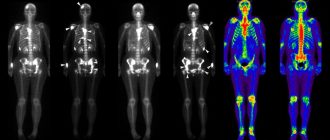Prostate Health Index PHI (Prostate Health Index) is an indicator of the likelihood of developing prostate cancer. The test requires the donation of a small amount of blood, which is preceded by a short preparatory period. This is one of the most modern and accurate tests for prostate cancer; it helps to avoid biopsies and false treatment.
What is a PHI Analysis?
Analysis for the prostate health index - a comprehensive blood examination for cancer markers. Gives 2.5 times more accurate results than PSA.
The first stages of prostate cancer are often asymptomatic, so men rarely undergo examination without experiencing symptoms. Late stages of prostate cancer are quite aggressive and life-threatening. Therefore, it is advisable to identify the initial stages.
The traditional method for screening prostate cancer is the PSA test. Unfortunately, often it and instrumental tests are not accurate enough to make a diagnosis, as a result of which a biopsy is prescribed. The Prostate Health Index allows you to avoid the need for it in case of PSA indicators that cannot be interpreted unambiguously and require it. According to statistics, about 75% of biopsy procedures after PSA give negative results for cancer, but lead to unnecessary anxiety for the patient.
Prostate Health Index is a comprehensive study of tumor markers with the most comprehensive indicators. It is calculated at PSA levels from 4 to 10 ng/ml, which indicate the presence of pathology, but do not give a clear picture. For this, 3 indicators of prostate-specific antigen are used - total, free and -2proPSA.
When performing PSA, its level may be elevated due to various pathologies, for example, prostatitis and adenoma, while the Prostate Health Index indicates only malignant tumors.
Due to its high practical efficiency and accuracy, the multifactorial PHI index is recognized as the most significant and minimally invasive method for diagnosing prostate cancer. It has already become widespread in the world and is gradually becoming the main method of examination.
Who should use PHI analysis?
A health index test for prostate cancer is indicated for the following symptoms:
- painful sensations in the groin and perineum;
- painful urination, frequent urge, feeling of incomplete emptying of the bladder;
- presence of blood in urine or semen;
- sexual dysfunctions, erection problems;
- painful sensations during ejaculation;
- when an organ enlargement is detected during instrumental examinations or palpation;
- for men during or after treatment for prostate cancer to control relapses.
The risk group includes:
- For men over 40 years of age, they are advised to undergo an annual PSA or Prostate Health Index examination.
- Close relatives (brothers and sons) of people who have been diagnosed with prostate cancer.
- People with an unhealthy diet (high in fatty meat products and low in vegetables and fruits).
- People who are overweight.
- Addicted to nicotine or alcohol.
Preparing for PHI Analysis
Preparation for the Prostate Health Index test includes the same points as for the PSA test:
- Typically, the examination is scheduled in the morning, because the results may vary within small limits during the day.
- Blood is drawn on an empty stomach; food intake is prohibited 8-12 hours before. 2 days before this you should switch to dietary nutrition.
- Quit coffee, alcohol and tobacco products in 2 days. If it is impossible to quit smoking, you should abstain for at least 2-3 hours before taking blood.
- The PHI test requires 2 days of abstinence from sexual intercourse.
- The day before donating blood, you need to refrain from physical and emotional stress, as well as hypothermia, baths and saunas.
- 2 weeks before the PHI examination, you need to refrain from any influence on the prostate, including TRUS, palpation and massage.
- The analysis is taken no earlier than a month after the biopsy and 6 months after urethral resection.
Passing a PHI analysis
The analysis requires taking blood from a vein from the patient; a small volume is needed, from 5 to 10 ml. Most often, the procedure is prescribed in the morning; before it is carried out, you should not consume food or any drinks, except for a small amount of still water.
Usually the patient is placed in a chair, but if he expresses anxiety or complains of dizziness, the procedure can be performed in a supine position.
The PHI test does not require lengthy interpretation of the results; they are usually ready within 24 hours.
Interpretation of results and norms of PHI analysis
There is no PHI standard as such; even with minimal values, there is a probabilistic risk of developing oncological processes. The following table is used to decipher the results:
- PHI from 0 to 27 – 9.8% probability of cancer;
- from 27 to 36 – 16.8%;
- from 36 to 55 – 33.3%;
- above 55 – 50.1%.
The higher the PHI value, the more likely it is that you will be referred for a biopsy, which will confirm or deny the presence of prostate cancer.



